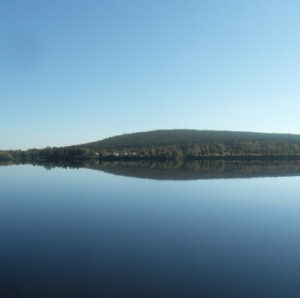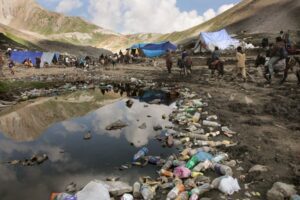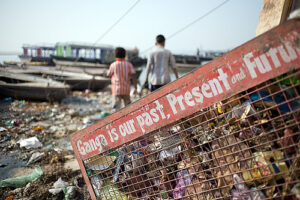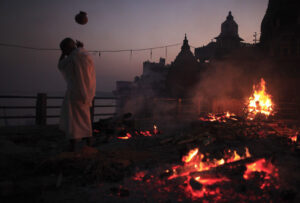
Water represents birth and rebirth. It cleans the body and also purifies it to some extent. These qualities confer a sacred status on water. In certain temples, many devotees take a dip in the holy waters and leave their clothes behind (which they believe will help wash away their sins). This blocks the flow of the water and pollutes it.
In some temples, devotees are permitted to take just a holy dip with their clothes on and are not allowed to use oil or soap. This system may be practiced by all temples to prevent waste generation and water pollution.
The Amarnath shrine is one of most revered sites. But the debris left behind is anything but sacred. By the end of the 55-day pilgrimage season, rubbish, including plastic bottles and bags, as well as human waste, can be found strewn across the mountain trails that wind through the fragile Himalayan environment. “There are more than 53 glaciers. Some of the rubbish falls into melted glaciers rushing through the valleys, threatening a vital source of drinking water for thousands of people who live downstream”.

Sacred rivers
Indian rivers are regarded as Goddess. Yet, the rivers of India are among the most polluted places on earth. The coliform pollution is among the highest in the rivers due to the dumping of untreated sewage. The organic and bacterial contamination is severe due to the discharge of untreated domestic waste water.
All the rivers have high levels of BOD. Yamuna, Ganga, Gomti, Ghaghra and Champal are among the most coliform polluted water bodies in India with concentration levels of about 500 mpn/100 ml.
Countless tanneries chemical plants, textile mills, distilleries, slaughterhouses and hospitals also dump their untreated waste into the river. Industrial effluents contribute to much of the pollution and are a cause for major concern because they are toxic and non-biodegradable.
400 million people live along the Ganga and an estimated 2 million persons bathe daily in the river. Some of the world’s oldest inhabited cities, like Varanasi and Patna (Pataliputra), are situated along its banks. It flows through over 70 cities and towns and provides water to about 40% of India’s population across 11 states, a population of about 500 million people, which is larger than any other river in the world. With fecal coliform counts up to 100,000,000 MPN (most probable number) per 100 ml, the Ganga today, is considered to be one of the most polluted rivers in the world. Even though the Government of India launched a Ganga Action Plan in 1986, spending Rs.9017 million, the pollution level merely increased. Now, a new project titled ‘Namaami Ganga’ has been launched in July 2014. The Yamuna contains 7500 coliform bacteria per 100 cc of water as per a 2012 estimate.


After the cremation of the deceased at Varanasi’s ghats, the bones and ashes are thrown into the Ganges. However, in the past thousands of uncremated bodies were thrown into the Ganges during cholera epidemics, spreading the disease. Even today, many bodies are floated free to decompose in the waters. In addition, those who cannot afford the large amount of wood needed to incinerate the entire body, leave behind a lot of half-burned body parts.
Rivers are sacred in India and every Hindu goes to the Ganga and other rivers to wash away their sins. Instead, they are absorbing new pollutants and consequent health hazards.


